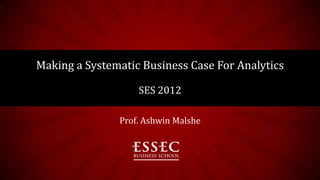Making a Systematic Business Case for Analytics
- 1. Making a Systematic Business Case For Analytics SES 2012 Prof. Ashwin Malshe
- 2. Why We Need to Make a Case for Analytics? • What’s the net present value (NPV) of business analytics? • No academic large-scale study exists that links analytics to firm performance – Brynjolffson et al. (2011) make an attempt • Most of current evidence is based on case studies – Most cases are published by analytics consultant/vendors/solution providers • IBM, SAS, SAP, Oracle, Teradata, etc.
- 3. The Circle of Mistrust Marketing Top Mgmt IT Finance HR
- 4. Obstacles to Analytics Adoption • Culture • Lack of business sponsor • Personal vs. organizational goals (short-/long-term) • Few employees who question the data and make judgments • Analytics skills are with too few employees • Poor information management • Lack of behavioral and anthropological training to IT
- 5. Types of Analytics • Descriptive – E.g., Dashboards • Predictive – E.g., Trend analysis • Prescriptive – E.g., Mathematical programming
- 6. Analytics Usage and Organizational Type Analytics Usage Descriptive and All three types High Predictive Descriptive Descriptive and Low Predictive Low High Data Driven
- 7. Analytics Usage and Organizational Type Analytics Usage Descriptive and All three types High Predictive Identify Descriptive Descriptive and the Low Predictive hindrance Low High Data Driven
- 8. Convincing Marketing Department • What are the benefits you are looking for? – Tracking customer satisfaction – Assessing and increasing ad effectiveness – Media planning – Social media metrics – Detecting trends – Segmentation and positioning – Something else… • E.g., Wal-Mart and 9/11
- 9. Convincing Marketing Department • Descriptive analytics – Use external vendors on a small scale for demonstrations • Predictive analytics – Work with academic institutions to build models • Run targeted experiments – Exploit insights from predictive analytics – Generate measurements for sales, market share, revenue growth, customer satisfaction, churn rate, repeat purchase, awareness, etc. • Evaluate the effectiveness of analytics insights
- 10. Managing Human Resources • Should you have an in-house analytics division? – Corporate or SBU division? • There are pitfalls to doing analytics in-house – Demand for skilled analytics labor is extremely high – Supply of skilled labor, unfortunately, is limited • Other options – Outsourcing – Hiring young graduates and training them – Training your existing employees
- 11. Outsourcing Analytics • Outsourcing poses problems – Data are sensitive • Privacy issues • Proprietary trade information • Legal barriers – Control on the analytics • Quality • Alignment of the objectives • Coordination
- 12. Hiring and Training • Hire young graduates from – Engineering – Economics – Statistics – Business management • Train them on data analysis and/or business management – Several online courses are available (e.g., Coursera) – Tie up with local business schools (e.g., ESSEC, SMU)
- 13. Training Existing Employees • Locate talent inside the organization – Organization-wide search – May have to overcome the departmental politics – There may be a large variance in the skill levels • Training alternatives – Using in-house facilities for training • Getting consultants and business schools to offer structured workshops – Part-time business analytics programs
- 14. Getting to the ROI • Analytics ROI at a staggering 10.66x (Nucleus Research 2011) – Does it make sense? • Survivorship bias (dolphins and 1,000 sailors), selection bias – If that’s true, what’s stopping everyone from using analytics? • ROI calculations are not straightforward – Attributing cost savings, incremental profits, etc. – What about the risk? – More difficult with intangible benefits
- 15. NPV Rules •
- 16. Business Success Barriers – IT, BI, etc. Source: Information Week
- 17. Working with the IT • Main challenges influenced by the culture – Data capture/collection (e.g., MeritTrac) – Data accessibility/sharing – Organization-wide data integration – Using real-time data dissemination • In the initial stages – Stick to available data formats – Avoid merging multiple databases – Avoid using too much unstructured data
- 18. Summary • Making a case for analytics needs systematic approach • In a non data-driven organization, there are many hurdles to overcome – ROI of analytics is one of the toughest one • Each function (HR, marketing, etc.) may have their own concerns for taking analytics route
- 19. Thank You Prof. Ashwin Malshe ESSEC Business School malshe@essec.edu Twitter: @ashwinmalshe



















